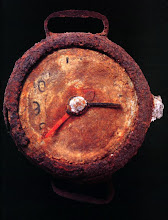Κάτω η Χούντα (Káto e Hoúnta: "Down with the Junta").
Still legible on a wall in the village of Kritou Terra, Pafos district: graffiti from the Spring or early Summer of 1974 - from the time between Ioannidis's 'coup within a coup' in Greece and the 15 July coup against Makarios in Cyprus.
Between the lines: After the student uprising in Greece was crushed by tanks at the Polytechnic University in Athens on 17 November 1973, splits within the military leadership came to a head. Papadopoulos was ousted by the hardliner Ioannidis. Under Ioannidis, the Greek Junta stepped up its campaign against Makarios, the elected President of the Cyprus Republic. Makarios, one of the two main leaders of the national liberation struggle against the British during the 1950s, had accepted the compromised sovereignty imposed on the new Republic, but continued to work diplomatically for the conditions of full Cypriot sovereignty. His strategy included an independent foreign policy that refused to subordinate Cyprus to US and British Cold War politics. (His independent diplomacy and participation in the Non-Aligned Movement led US critics to smear him as "the Castro of the Mediterranean.")
The Junta in power in Greece since the 1967 coup actively sought to replace Makarios with a more pliable figure. It encouraged ultra-nationalists in Cyprus to revive the goal of enosis, or union with Greece, and sponsored the right-wing paramilitary group EOKA-B. Several attempts were made to assassinate Makarios. By Spring of 1974, with Ioannidis in power in Greece, Makarios's intelligence service uncovered evidence of an impending coup. On 2 July, Makarios published an open letter to the Greek Junta, protesting their interference. The reply came on 15 July, when Greek officers of the Cypriot National Guard launched a full attack on the presidential palace. Makarios escaped, but had to flee the island, and ultra right-wing trigger-man Nikos Sampson was installed as interim leader. Five days later, Turkey invaded Cyprus.
Behind the scenes: US imperialism. In the distracting confusion of Watergate and Nixon's fall, Kissinger gained a freer hand to shape and micromanage US foreign policy. He used the agencies of US power to push the crisis between Makarios and the Greek Junta toward an outcome that would maintain Cyprus as a NATO force platform. This entailed eliminating Makarios, but also containing the conflict without a war between Greece and Turkey. The forced partition of the island under Turkish arms would accomplish this, as long as US acceptance was clearly signaled. The self-styled Metternich struck again. And Cypriot aspirations to self-determination were once again brutally subordinated to the Cold War calculus. In the aftermath of spilled blood, occupation and forced removals, Turkey was appeased, Greece was disciplined without conceding "too much" democracy, and British military bases and US spy stations continued to operate.
Still legible on a wall in the village of Kritou Terra, Pafos district: graffiti from the Spring or early Summer of 1974 - from the time between Ioannidis's 'coup within a coup' in Greece and the 15 July coup against Makarios in Cyprus.
Between the lines: After the student uprising in Greece was crushed by tanks at the Polytechnic University in Athens on 17 November 1973, splits within the military leadership came to a head. Papadopoulos was ousted by the hardliner Ioannidis. Under Ioannidis, the Greek Junta stepped up its campaign against Makarios, the elected President of the Cyprus Republic. Makarios, one of the two main leaders of the national liberation struggle against the British during the 1950s, had accepted the compromised sovereignty imposed on the new Republic, but continued to work diplomatically for the conditions of full Cypriot sovereignty. His strategy included an independent foreign policy that refused to subordinate Cyprus to US and British Cold War politics. (His independent diplomacy and participation in the Non-Aligned Movement led US critics to smear him as "the Castro of the Mediterranean.")
The Junta in power in Greece since the 1967 coup actively sought to replace Makarios with a more pliable figure. It encouraged ultra-nationalists in Cyprus to revive the goal of enosis, or union with Greece, and sponsored the right-wing paramilitary group EOKA-B. Several attempts were made to assassinate Makarios. By Spring of 1974, with Ioannidis in power in Greece, Makarios's intelligence service uncovered evidence of an impending coup. On 2 July, Makarios published an open letter to the Greek Junta, protesting their interference. The reply came on 15 July, when Greek officers of the Cypriot National Guard launched a full attack on the presidential palace. Makarios escaped, but had to flee the island, and ultra right-wing trigger-man Nikos Sampson was installed as interim leader. Five days later, Turkey invaded Cyprus.
Behind the scenes: US imperialism. In the distracting confusion of Watergate and Nixon's fall, Kissinger gained a freer hand to shape and micromanage US foreign policy. He used the agencies of US power to push the crisis between Makarios and the Greek Junta toward an outcome that would maintain Cyprus as a NATO force platform. This entailed eliminating Makarios, but also containing the conflict without a war between Greece and Turkey. The forced partition of the island under Turkish arms would accomplish this, as long as US acceptance was clearly signaled. The self-styled Metternich struck again. And Cypriot aspirations to self-determination were once again brutally subordinated to the Cold War calculus. In the aftermath of spilled blood, occupation and forced removals, Turkey was appeased, Greece was disciplined without conceding "too much" democracy, and British military bases and US spy stations continued to operate.
The graffiti probably dates from between Makarios's public letter of 2 July and the coup thirteen days later. The village of Kritou Terra, we're told, was a stronghold of Makarios supporters - center-nationalist rather than leftist, but pro-democracy and anti-Junta.
AP/GR




Thanks GRAP ! lol. I posted it on the facebook and several of my friends re-posted it. xoj
ReplyDeletethanks J guitar! scurvy tunes would be poor without you...
ReplyDelete